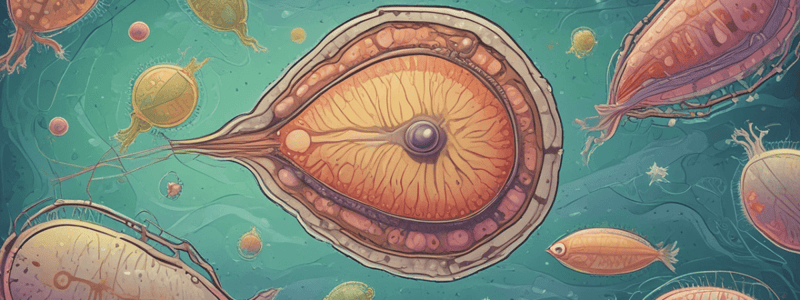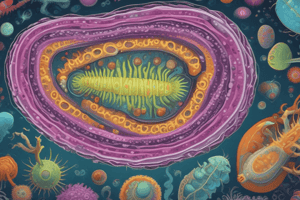Podcast
Questions and Answers
Which type of transmission may occur via contaminated blood transfusion?
Which type of transmission may occur via contaminated blood transfusion?
- Human to human transmission (correct)
- Fecal-oral transmission
- Airborne transmission
- Vector transmission
What is the frequency of retroinfection in Enterobius vermicularis?
What is the frequency of retroinfection in Enterobius vermicularis?
- Rare
- Frequent
- Never occurs
- Unknown (correct)
How long does it take for Trichuris trichiura females to start ovipositing after infection?
How long does it take for Trichuris trichiura females to start ovipositing after infection?
- 6 months
- 30 to 40 days
- 60 to 70 days (correct)
- 3 to 4 months
What is the life span of adult Ascaris lumbricoides?
What is the life span of adult Ascaris lumbricoides?
How long does it take for Necator americanus to develop from ingestion of infective eggs to oviposition by the adult female?
How long does it take for Necator americanus to develop from ingestion of infective eggs to oviposition by the adult female?
What is a unique feature of Ancylostoma duodenale larvae?
What is a unique feature of Ancylostoma duodenale larvae?
What is a feature of the Strongyloides stercoralis life cycle?
What is a feature of the Strongyloides stercoralis life cycle?
What happens to rhabditiform larvae in the gut of Strongyloides stercoralis?
What happens to rhabditiform larvae in the gut of Strongyloides stercoralis?
What is the definitive host in the life cycle of Diphyllobothrium?
What is the definitive host in the life cycle of Diphyllobothrium?
What is the infective stage of Echinococcus granulosus?
What is the infective stage of Echinococcus granulosus?
What is the diagnostic stage of Fasciola hepatica?
What is the diagnostic stage of Fasciola hepatica?
What is the infective stage of Fasciolopsis buski?
What is the infective stage of Fasciolopsis buski?
What is the diagnostic stage of Clonorchis sinensis?
What is the diagnostic stage of Clonorchis sinensis?
What happens if hydatid cysts rupture in Echinococcus granulosus?
What happens if hydatid cysts rupture in Echinococcus granulosus?
What is the average length of adult worms after maturation of the parasites?
What is the average length of adult worms after maturation of the parasites?
How do humans acquire Diphyllobothrium?
How do humans acquire Diphyllobothrium?
How many eggs can an adult Diphyllobothrium discharge per day?
How many eggs can an adult Diphyllobothrium discharge per day?
How do eggs reach the environment in the mammalian host?
How do eggs reach the environment in the mammalian host?
What is the life span of adult worms in the absence of internal autoinfection?
What is the life span of adult worms in the absence of internal autoinfection?
What is the vector responsible for transmitting Mansonella ozzardi?
What is the vector responsible for transmitting Mansonella ozzardi?
What is the mode of transmission of Dipylidium caninum?
What is the mode of transmission of Dipylidium caninum?
What is the diagnostic stage of Mansonella perstans?
What is the diagnostic stage of Mansonella perstans?
Which of the following is NOT a characteristic of Mansonella streptocerca?
Which of the following is NOT a characteristic of Mansonella streptocerca?
What is the primary intermediate host of Diphyllobothrium latum?
What is the primary intermediate host of Diphyllobothrium latum?
What is the infective stage of Taenia saginata?
What is the infective stage of Taenia saginata?
What is the diagnostic stage of Hymenolepis nana?
What is the diagnostic stage of Hymenolepis nana?
What is the intermediate host of Hymenolepis diminuta?
What is the intermediate host of Hymenolepis diminuta?
How do humans acquire infection of Dipylidium caninum?
How do humans acquire infection of Dipylidium caninum?
What is the mode of transmission of Diphyllobothrium latum?
What is the mode of transmission of Diphyllobothrium latum?
How is Hymenolepis diminuta typically transmitted?
How is Hymenolepis diminuta typically transmitted?
What occurs shortly after the cysticercoid larvae of Hymenolepis diminuta are released in the stomach and small intestine?
What occurs shortly after the cysticercoid larvae of Hymenolepis diminuta are released in the stomach and small intestine?
How do the parasites of Hymenolepis diminuta attach to the small intestine wall?
How do the parasites of Hymenolepis diminuta attach to the small intestine wall?
What is the term used to describe the parasitic infection of blood?
What is the term used to describe the parasitic infection of blood?
Which of the following is NOT a complication of Trypanosoma cruzi infection?
Which of the following is NOT a complication of Trypanosoma cruzi infection?
What is the term used to describe the restriction analysis of kinetoplast DNA technique?
What is the term used to describe the restriction analysis of kinetoplast DNA technique?
Which of the following is a characteristic of Trypanosoma brucei gambiense?
Which of the following is a characteristic of Trypanosoma brucei gambiense?
What is the term used to describe the umbrella term often used to refer to the blepharoplast and small parabasal body?
What is the term used to describe the umbrella term often used to refer to the blepharoplast and small parabasal body?
Which of the following is NOT a species of Plasmodium?
Which of the following is NOT a species of Plasmodium?
What is the term used to describe the inability of an individual to mount an adequate immune response?
What is the term used to describe the inability of an individual to mount an adequate immune response?
Which of the following is a complication of Babesia infection?
Which of the following is a complication of Babesia infection?
Flashcards are hidden until you start studying
Study Notes
Leishmania Complexes
- Leishmania donovani complex:
- Leishmania Mexicana complex:
- Leishmania tropica complex:
Trypanosoma
- Trypanosoma brucei gambiense:
- Vector: Tsetse fly
- Trypanosoma brucei rhodiesiense:
- Vector: Tsetse fly
- Trypanosoma cruzi:
- Vector: Triatomine bug
- Life cycle:
- Infections can occur through contaminated blood transfusions
- Trypanosoma rangeli:
- Vector: Triatomine bug
Definition of Terms
- Blepharoplast: Basal body structure
- Kinetoplast: Umbrella term for blepharoplast and small parabasal body
- Parasitemia: General term for describing parasitic infection of blood
- Schizodeme analysis: Restriction analysis of kinetoplast DNA technique
- Zymodeme analysis: Restriction analysis of isoenzyme pattern technique
- Pruritis: Intense itching
- Anergic: Inability of an individual to mount an adequate immune response
- Nagana: Form of the disease often found in cattle
- Chancre: Ulcer
- Malaise: General feeling of discomfort, illness, or uneasiness whose exact cause is difficult to identify
- Lymphadenomaly: Lymph node enlargement
- Kerandel's sign: Delayed sensation to pain
- Somnolence: Excessive sleepiness
- Myalgia: Pain in a muscle or group of muscles
- Glomerulonephritis: Subsequent kidney damage
- Myocarditis: Inflammation of the heart
- Chagoma: Development of an erythamous nodule
- Romana's Sign: Characteristic conjunctivitis and unilateral edema of the eyelids
- Megacolon: Enlargement of colon
- Megaesophagus: Enlargement of esophagus
- Hepatosplenomegaly: Enlargement of liver and spleen
- Cardiomegaly: Enlargement of heart
Plasmodium and Babesia
- Plasmodium vivax:
- Plasmodium ovale:
- Plasmodium malariae:
- Plasmodium falciparum:
- Babesia species:
- Human to human transmission may occur via contaminated blood transfusions
- Babesia microti:
- Life cycle:
Nematodes
- Enterobius vermicularis:
- Life cycle:
- Retroinfection: Migration of newly hatched larvae from the anal skin back into the rectum
- Trichuris trichiura:
- Life cycle:
- Female worms in the cecum shed between 3,000 and 20,000 eggs per day
- Ascaris lumbricoides:
- Life cycle:
- Adult worms can live 1 to 2 years
- Necator americanus:
- Life cycle:
- Ancylostoma duodenale:
- Life cycle:
- Some A.duodenale larvae can become dormant and re-activate to establish patent infections
- Strongyloides stercoralis:
- Life cycle:
- Autoinfection: Filariform larvae can penetrate the intestinal mucosa or skin, resulting in autoinfection
- Mansonella ozzardi:
- Life cycle:
- Infective stage: L3 Larva enters bite wound
- Diagnostic stage: Unsheathed microfilaria
- Vector: Sucking midge or blackfly
- Mansonella perstans:
- Life cycle:
- Infective stage: L3 Larva enters bite wound
- Diagnostic stage: Unsheathed microfilaria
- Vector: Biting midges of the genus Culicoides
- Mansonella streptocerca:
- Life cycle:
- Infective stage: L3 Larva enters bite wound
- Diagnostic stage: Unsheathed microfilaria
- Vector: Biting midges of the genus Culicoides
Cestodes
- Taenia saginata:
- Taenia solium:
- Life cycle:
- Infective stage: Cysticercus larva present in meat
- Diagnostic stage: Eggs on gravid proglottids in feces
- Mode of transmission: Ingestion of contaminated meat
- Hymenolepis diminuta:
- Life cycle:
- Infective stage: Cysticercus in body cavity of insects ingested by rodent or human
- Diagnostic stage: Eggs passed in feces
- Mode of transmission: Ingestion of insects in precooked cereals or other foods and directly from environment
- Hymenolepis nana:
- Life cycle:
- Infective stage: Cysticercoid infected arthropod or embryonated eggs
- Diagnostic stage: Embryonated eggs
- Intermediate host: Beetles and fleas
- Mode of transmission: Internal autoinfection or ingestion of contaminated food
- Dipylidium caninum:
- Life cycle:
- Infective stage: Cysticercoid in fleas
- Diagnostic stage: Gravid proglottids and eggs
- Intermediate host: Larval stage of dog flea and cat flea
- Mode of transmission: Dog and cat licking the host; Hand-to-Mouth contamination; Ingestion of contaminated food
- Diphyllobothrium latum:
- Life cycle:
- Primary intermediate host: Cyclops species crustacean
- Secondary intermediate host: Perch fish and Pike fish
- Paratenic host: Predator fish as transport host
- Infective stage: Pleocercoid/Pleurocercoid larvae
- Diagnostic stage: Unembryonated eggs
- Mode of transmission: Ingestion of undercooked paratenic host
- Echinicoccus granulosus:
- Life cycle:
- Infective stage: Embryonated eggs in feces
- Diagnostic stage: Alveolar hydatid cyst in various organs
- Mode of transmission: Ingestion of eggs
- Humans are aberrant intermediate hosts, and become infected by ingesting eggs
Trematodes
- Fasciolopsis buski:
- Life cycle:
- Infective stage: Metacercariae on water plants
- Diagnostic stage: Unembryonated eggs
- Mode of transmission: Ingestion of contaminated plants
- Fasciola hepatica:
- Life cycle:
- Infective stage: Metacercariae on vegetation
- Diagnostic stage: Unembryonated eggs
- Mode of transmission: Ingestion of contaminated plants
- Clonorchis sinensis:
- Life cycle:
- Infective stage: Metacercariae in contaminated fresh water fish
- Diagnostic stage: Embryonated eggs
- Mode of transmission: Ingestion of contaminated fish
Studying That Suits You
Use AI to generate personalized quizzes and flashcards to suit your learning preferences.




